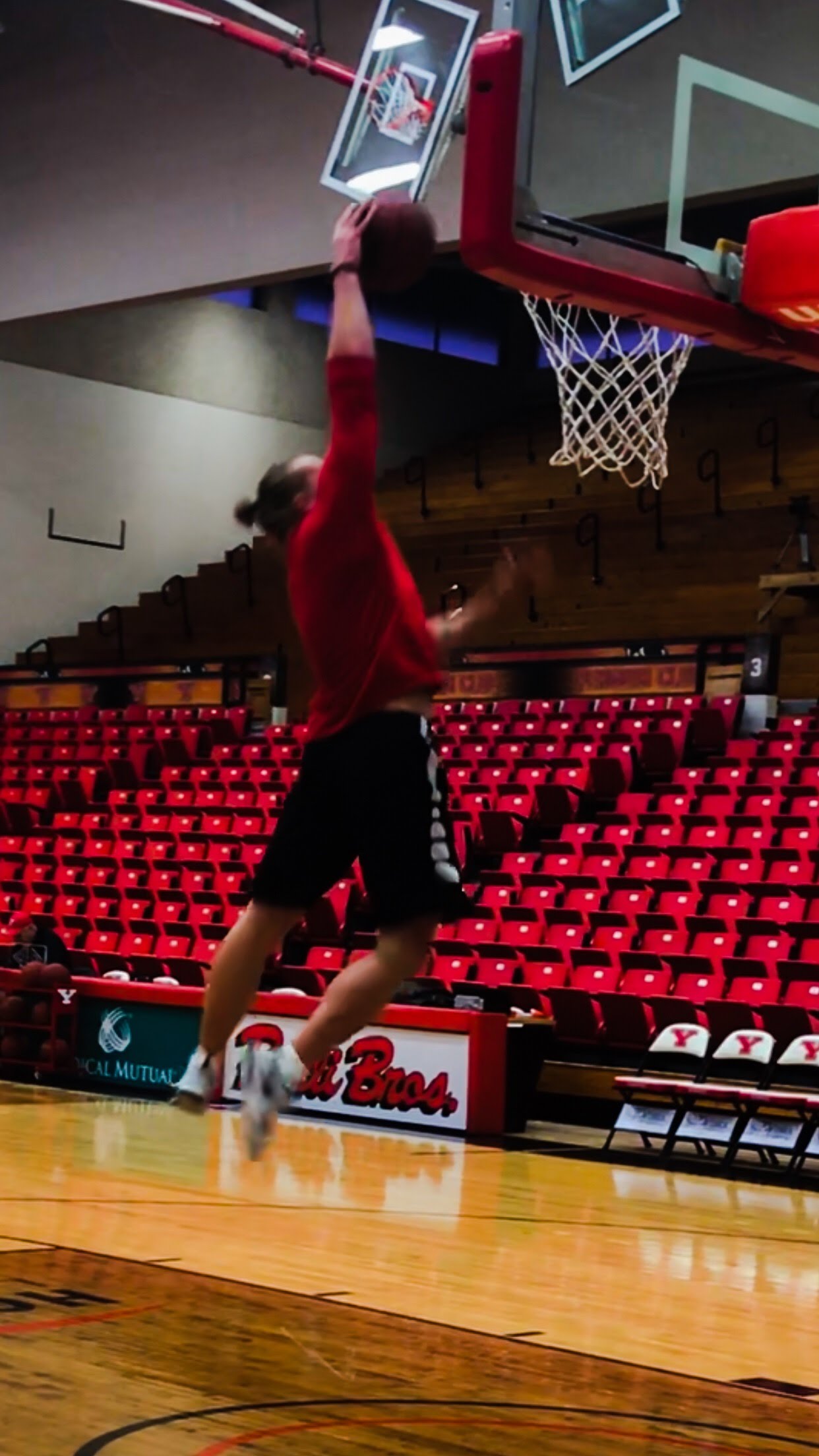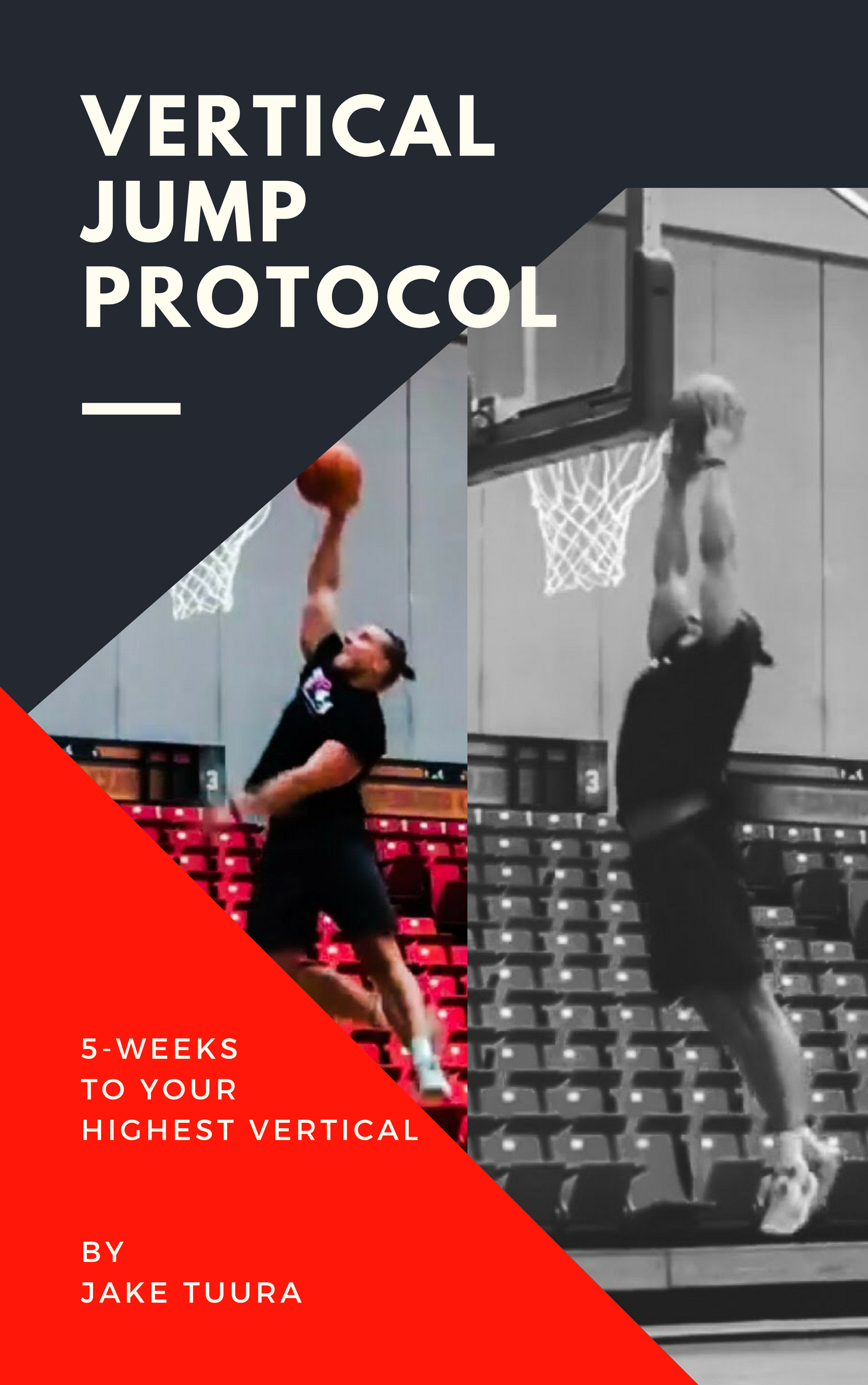Paradox. Noun: a seemingly absurd or self-contradictory statement or proposition that when investigated or explained may prove to be well founded or true.
As a young basketball player, my dream was to dunk a basketball.
During high school, I experimented with vertical jumping programs. After years of hard training, I was disappointed – I still couldn’t dunk, I developed patellar tendonitis, and I was forced to take years off from playing basketball.
I gave up on my goals of dunking, watched Pumping Iron, and got into bodybuilding.
Occasionally, I’d test my vertical jump throughout the year.
When my legs were lacking, I tried daily maximal back squatting. I got stronger, my vertical jump improved, but I still wasn’t dunking.
Then I read Triphasic Training and did a few weeks of slow eccentric (lengthening) work paired with plyometrics. The eccentrics consisted of squatting heavy with a 4-5 second tempo on the lowering portion. After 3 weeks of training, I tested my vertical – I could finally dunk.
It made no sense to me. How could training slow make me more explosive?
So I tried it out with high school and college basketball players. The same result – athletes jump higher. Those that were close to dunking were now throwing it down with ease.
A paradox was developed: Training slow increases vertical jump. It makes no sense – but digging in to the physiology proves otherwise.
Sidenote: Eccentric training also cleared up my patellar tendonitis. It’s an effective method to deal with injuries [14, 29].
Eccentric Strength and Performance
Muscle contraction exists in three phases: lengthening, stopping, and shortening.
These are known as: eccentric, isometric, and concentric.
Before you jump, you dip down (eccentric phase). Before you throw a baseball, you cock back your arm (eccentric phase). Before you cut, you load up your legs (eccentric phase).
In the eccentric, muscle and tendon are stretched. Eccentric strength refers to the musculotendon’s ability to produce and resist force while lengthening.
The research:
Vertical Jump. Jumping is positively related to eccentric strength [6, 31] and eccentric rate of force development [19].
Eccentric training has been shown to increase vertical jump height [9, 21, 28].
Change of Direction. Eccentric strength is a predictor of change of direction (COD) performance [33], deceleration and sprinting [27]. Being stronger eccentrically can explain COD speed variance among athletes [15, 32].
Eccentric training has been show to improve COD ability [12] by increasing force absorption while cutting [16].
By training with heavy, slow eccentrics, you are improving your muscle and tendon’s ability to manage high muscle tension. This was the benefit I saw when my vertical shot up and what I recommend for those initially starting a program.
However, to optimize eccentric strength, you have to train at a high eccentric speed – NOT slowly (more on this later).
Eccentric Strength and Elastic Energy
During an eccentric contraction, you are stretching elastic structures in your muscle and tendon. When this happens, muscle and tendon behave like springs [21].
And when you stretch springs, they store elastic recoil energy [17, 23].
Springs exist on a continuum: compliance to stiffness. If your musculotendon springs are stiff, they will store more elastic energy when stretched. And because elastic energy increases athletic performance [3, 5, 11, 25, 30], a high level of stiffness is exactly what you want.
Tendon stiffness adapts most to the highest loading magnitude [4]. The best gains in tendon stiffness come from high strain [1, 2, 24], training with low strain or low resistance does not work [18]. Eccentric training has the capacity to overload the musculotendon system more than regular training because eccentric strength is greater than concentric strength [20]. This means a high strain, or tension can be force upon the tendon system – forcing stiffness adaptations.
Muscle stiffness also adapts in the same manner. High amounts of muscle forces and energy absorbed from eccentric training paired with jumping causes an increase in muscle stiffness [21, 28].
Athletes with more eccentric leg strength have more stiffness of the lower extremity [26]. When they dip down before a jump, their springs resist lengthening better because they’re able to tolerate higher stretch loads. This leads to more energy storage [10] as eccentric strength is a major factor in energy storage capability [16]. A high level of eccentric strength ultimately leads to high muscle power output [20] during explosive athletic movements.
Eccentric Strength and Eccentric Velocity
The faster an athlete descends, the more powerful they will be.
Study #1: In a countermovement jump, the more vigorous the descent, the higher the jump [22].
Study #2: In plyometric training, a faster descent elicits more advantage in vertical jump performance than a slower descent [35].
Study #3: In 48 trained Track and Field athletes, jump height significantly correlates with eccentric (descending) velocity [13].
Eccentric velocity is determined by eccentric strength. If your musculotendon springs cannot withstand the force of a fast descent, your body won’t let you. Fast athletes have springs that are able to deal with a high amount of force [7, 8]. This is because they are strong eccentrically [34]. If you want to descend fast, you must build the capacity to do so (eccentric strength).
Take your major exercises: Squats, bench presses, and pulls, and perform them with a controlled eccentric for a few weeks to let the muscle and tendon adapt. Then, once comfortable with the exercises, perform them as explosively as possible, both on the eccentric and the concentric. This will maximize eccentric strength, elastic energy storage and utilization, and eccentric velocity capacity. This is a feature of the Vertical Jump Protocol.
Pair these strength moves (slow or fast) with plyometrics for a synergistic effect [9].
Use band-resistance to force your body into a greater eccentric velocity.
Or as I recommend, the French Contrast Method:
Ensure your core and spinal erectors are strong enough to manage a high eccentric velocity while jumping. Otherwise, your eccentric velocity gains will not transfer to actual vertical jump gains. Again, this core and spinal erector training are covered in the Vertical Jump Protocol.
Share this on Facebook & Join the Conversation


I'm able to dunk again so whatever we're doing is definitely working
Christian H. - Former Collegiate Baseball Player
PURCHASE HYPERTROPHY CLUSTER PROTOCOL HERE
REFERENCES
[1] Arampatzis, A., Karamanidis, K., & Albracht, K. (2007). Adaptational responses of the human Achilles tendon by modulation of the applied cyclic strain magnitude. The Journal of Experimental Biology, 210(Pt 15), 2743-53.
[2] Arampatzis, A., Peper, A., Bierbaum, S., & Albracht, K. (2010). Plasticity of human Achilles tendon mechanical and morphological properties in response to cyclic strain. Journal of Biomechanics, 43(16), 3073-9.
[3] Bobbert M. F. & Casius, L. J. (2005). Is the effect of a countermovement on jump height due to active state development? Medicine and Science in Sports and Exercise, 37(3), 440-6.
[4] Bohm, S., Mersmann, F., & Arampatzis, A. (2015). Human tendon adaptation in response to mechanical loading: a systemic review and meta-analysis of exercise intervention studies on healthy adults. Sports Medicine Open, 1(1), 7.
[5] Bosco, C., Komi, P. V., & Ito, A. (1981). Prestretch potentiation of human skeletal muscle during ballistic movement. Acta Physiologica Scandinavica, 111(2), 135-40.
[6] Bridgeman, L. A., McGuigan, M. R., Gill, N. D., & Dulson, D. K. (2016). Relationships between concentric and eccentric strength and countermovement jump performance in resistance trained men. Journal of Strength and Conditioning Research, DOI: 10.1519/JSC.0000000000001539.
[7] Chumanov, E. S., Heiderscheit, B. C., & Thelen, D. G. (2007). The effect of speed and influence of individual muscles on hamstring mechanics during the swing phase of sprinting. Journal of Biomechanics, 40(16), 3555-62.
[8] Chumanov, E. S., Heiderscheit, B. C., & Thelen, D. G. (2011). Hamstring musculotendon dynamics during stance and swing phases of high-speed running. Medicine and Science in Sports and Medicine, 43(3), 525-32.
[9] Cook, C. J., Beaven, C. M., & Kilduff, L. P. (2013). Three weeks of eccentric training combined with overspeed exercises enhances power and running speed performance gains in trained athletes. Journal of Strength and Conditioning Research, 27(5), 1280-6.
[10] Cormie, P., McGuigan, M. R., & Newton, R. U. (2010). Changes in the eccentric phase contribute to improved stretch-shorten cycle performance after training. Medicine and Science in Sports and Exercise, 42(9), 1731-44.
[11] Dal Pupo, J., Detanico, D., & dos Santos, S. G. (2012). Kinetic parameters as determinants of vertical jump performance. Brazilian Journal of Kinanthropometry and Human Performance, 14(1), 41-51.
[12] de Hoyo, M., Sañudo, B., Carrasco, L., Mateo-Cortes, J., Domínguez-Cobo, S., Fernandes, O., Del Ojo, J. J. & Gonzalo-Skok, O. (2016). Effects of 10-week eccentric overload training on kinetic parameters during change of direction in football players. Journal of Sports Sciences, 34(14), 1380-7.
[13] González-Badillo, J. J. & Marques, M. C. (2010). Relationship between kinematic factors and countermovement jump height in trained track and field athletes. Journal of Strength and Conditioning Research, 24(12), 3443-7.
[14] Goode, A. P., Reiman, M. P., Harris, L., DeLisa, L., Kauffman, A., Beltramo, D., Poole, C., Ledbetter, L., & Taylor, A. B. (2015). Eccentric training for prevention of hamstring injuries may depend on intervention compliance: a systematic review and meta-analysis. British Journal of Sports Medicine, 49(6), 349-56.
[15] Jones, P., Bampouras, T. M., & Marrin, K. (2009). An investigation into the physical determinants of change of direction speed. The Journal of Sports Medicine and Physical Fitness, 49(1), 97-104.
[16] Kay, A. D., Richmond, D., Talbot, C., Mina, M., Baross, A. W., & Blazevich, A. J. (2016). Stretching of active muscle elicits chronic changes in multiple strain risk factors. Medicine and Science in Sports and Exercise, 48(7), 1388-96.
[17] Kim. S. (2012). An effect of the elastic energy stored in the muscle-tendon complex at two different coupling-time conditioning during vertical jump. Advances in Physical Education, 3(1), 10-14.
[18] Kongsgaard, M., Reitelseder, S., Pedersen, T. G., Holm, L., Aagaard, P., Kjaer, M., & Magnusson, S. P. (2007). Region specific patellar tendon hypertrophy in humans following resistance training. Acta Physiologica (Oxford, England), 191(2), 111-21.
[19] Laffaye, G. & Wagner, P. (2013). Eccentric rate of force development determines jumping performance. Computer Methods in Biomechanics and Biomedical Engineering, 16(S1), 82-83.
[20] LaStayo, P. C., Woolf, J. M., Lewek, M. D., Snyder-Mackler, L., Trude-Reich, Lindstedt, S. L. (2003). Eccentric muscle contractions: Their contribution to injury, prevention, rehabilitation, and sport. Journal of Orthopaedic & Sports Physical Therapy, 33(10), 557-71.
[21] Linstedt, S. L., LaStayo, P. C., & Reich, T. E. (2001). When active muscle lengthen: properties and consequences of eccentric contractions. News in physiological sciences: an international journal of physiology produced jointly by the International Union of Physiological Sciences and the American Physiological Society, 16(6), 256-61.
[22] Linthorne, N. P. (2001). Analysis of standing vertical jumps using a force platform. American Journal of Physiology, 69(11), 1198-204.
[23] Maganaris, N. C. & Paul, J. P. (1999). In vivo human tendon mechanical properties. The Journal of Physiology, 521(Pt 1), 307-313.
[24] Malliaras, P., Kamal, B., Nowell, A., Farley, T., Dhamu, H., Simpson, V., Morissey, D., Langberg, H., Maffulli, N., & Reeves, N. D. (2013). Patellar tendon adaptation in relation to load-intensity and contraction type. Journal of Biomechanics, 46(11), 1893-9.
[25] McBride, J. M., McCaulley, G. O., & Cormie, P. (2008). Influence of preactivity and eccentric muscle activity on concentric performance during vertical jumping. Journal of Strength and Conditioning Research, 22(3), 750-7.
[26] McMahon, J. & Graham-Smith, P. (2010). Relationship between lower extremity stiffness and eccentric leg strength in horizontal jumpers. Conference: International Society of Biomechanics in Sports Congress.
[27] Naylor, J. & Greig, M. (2015). A hierarchical model of factors influencing a battery of agility tests. The Journal of Sports Medicine and Physical Fitness, 55(11), 1329-35.
[28] Papadopoulos, C., Theodosiou, K., Bogdanis, G. C., Gkantiraga, E., Gissis, I., Sambanis, M., Souglis, A., & Sotiropoulos, A. (2014). Multiarticular isokinetic high-load eccentric training induces large increases in eccentric and concentric strength and jumping performance. Journal of Strength and Conditioning Research, 28(9), 2680-8.
[29] Petersen, J., Thorborg, K., Nielsen, M. B., Budtz-Jørgensen, E., & Hölmich, P. (2011). Preventive effect of eccentric training on acute hamstring injuries in men’s soccer: a cluster-randomized controlled trial. The American Journal of Sports Medicine, 39(11), 2296-303.
[30] Roberts, T. J. & Konow, N. (2013). How tendons buffer energy dissipation by muscle. Exercise and Sport Sciences Reviews, 41(4), 186-93.
[31] Seyfarth, A. Blickhan, R. & Leeuwen Van J. L. (2000). Optimum take-off techniques and muscle design for long jump. Journal of Experimental Biology, 203, 741-50.
[32] Spiteri, T., Newton, R. U., Binetti, M., Hart, N. H., Sheppard, J. M., & Nimphius, S. (2015). Mechanical determinants of faster change of direction and agility performance in female basketball athletes. Journal of Strength and Conditioning Research, 29(8), 2205-14.
[33] Spiteri, T., Nimphius, S., Hart, N. H., Specos, C., Sheppard, J. M., & Newton, R. U. (2014). Contribution of strength characteristics to change of direction and agility performance in female basketball athletes. Journal of Strength and Conditioning Research, 28(9), 2415-23.
[34] Stanton, P. & Purdham, C. (1989). Hamstring injuries in sprinting – the role of eccentric exercise. The Journal of orthopaedic and sports physical therapy, 10(9), 343-9.
[35] Toumi, H., Best, T. M., Martin, A., F’Guyer, S., Poumarat, G. (2004). Effects of eccentric phase velocity of plyometric training on the vertical jump. International Journal of Sports Medicine, 25(5), 391-8.








